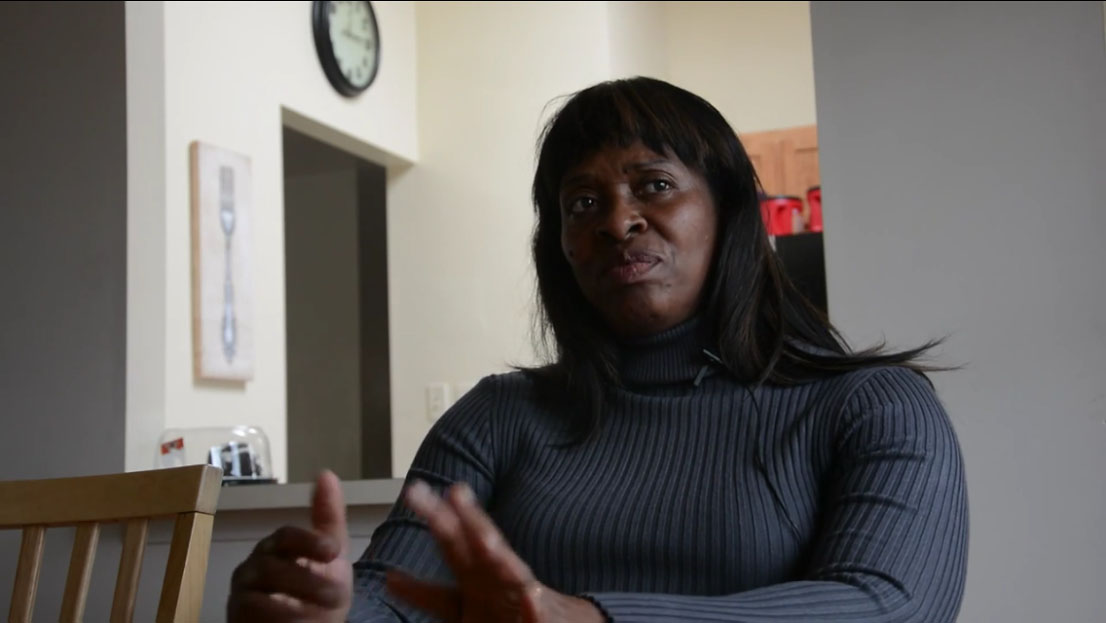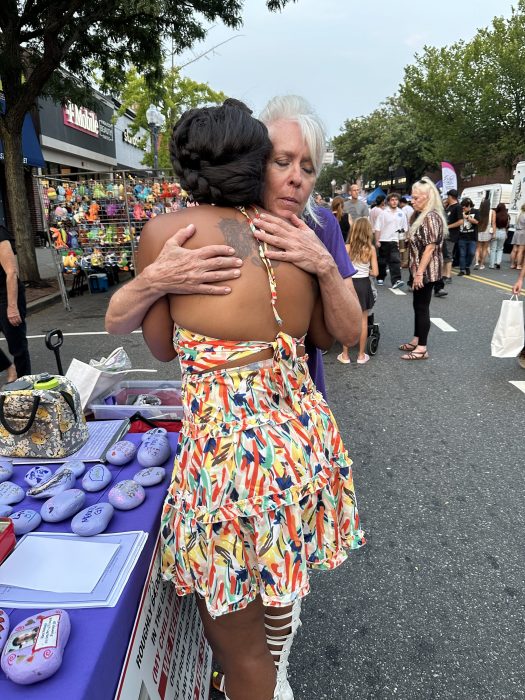In the hamlet of Roosevelt, on the South Shore of Long Island, is the home of Soldiers in Sobriety. It’s a two-story house on East Raymond Avenue, an anonymous building set on the quiet side street. Dorothy Henderson, an ex-drug dealer who now helps women rebuild their lives after drug addiction, owns the house.
Many of the residents have children and are trying to regain custody after seeing their worlds crumble from addiction. Others are trying to earn enough money to start a family. Soldiers in Sobriety is a safe house, providing housing, support meetings and cooked dinners, as well as the camaraderie that comes from shared experience.
Josephine Hodge, a 52-year-old resident at Soldiers in Sobriety, says that the house has helped her recovery from a crack cocaine addiction.
“We may have come here as broken women, but we want to leave here 100-percent whole,” Hodge says, sitting at the kitchen table in the two-story house. “We have to want the best for ourselves.”
This house was Henderson’s dream, a long-term goal that she put into motion after she started attending Hempstead Council of Thought and Action, or COTA, meetings, six years ago. COTA began in January 2008, and Henderson started attending soon after she was released from prison that year for drug dealing. Henderson is one of the COTA originals, one who was inspired to take control of her life after years of “dipping and dabbing” in the drug trade.
COTA is a grass-roots movement developed by Suffolk County’s Deputy Police Commissioner Risco Mention-Lewis in 2008 while she was working as an assistant District Attorney for Nassau County. It is a response to communities that are economically or socially repressed – often both – and works to change the mindset of residents through council meetings where members can discuss the week’s events and evaluate what needs to change. Mention-Lewis says she hopes COTA becomes a grassroots movement that changes the culture of communities where drug dealing, gang violence and prison sentences are common problems.
During her own time in prison, Henderson, now in her late 50s, became a Credited Alcohol and Substance Abuse Counselor, which gave her the credentials to open the house. She also had a powerful force on her side: Mention-Lewis.
For Henderson, Mention-Lewis is more than a friend. She is on Henderson’s “board of advisers,” a mentorship term that COTA members use. A COTA member’s board of advisers provides advice and accountability. It is made up of those who will celebrate the successes of a member and help to manage the weaknesses.
Robin Harris has known Henderson for 15 years and has seen the change that COTA has made in her friend’s life. “If there wasn’t a COTA out there, it could have gone either way,” Harris said. “She’d been out in the streets for 20, 30 years. If there wasn’t a COTA for her to come back to, I don’t know if she would have had something to help her turn her life around.”
Henderson is like many COTA members working to help others who are trying to rebuild their lives. She brings up the COTA mantra repeated at the end of every meeting: Your thoughts become actions, actions become habits, habits become character and character becomes destiny.
COTA has expanded from its Hempstead roots, opening meetings in Wyandanch and North Bellport in Suffolk County. These newer COTAs are beginning to bear fruit.
“Through COTA, good men become visible again,” Mention-Lewis said. “It gives them hope, it gives them focus and direction, and it gives them networking and helps them find their purpose.”
Each council meets weekly and works to focus members, while connecting them with local business owners or community members who can provide employment or mentorship.
The neighborhoods COTA serves have a lot of common problems, often related to crime and gang violence. Each is isolated from the stereotypical Long Island narrative of prosperity and suburban comfort. They are racially and economically separate. And this, say researchers, is what creates a vicious cycle.
“Suburban regions that are more racially segregated have higher crime rates overall,” said John Logan, a sociologist from Brown University who devotes much of his research to studying American racial segregation.
Segregated communities tend to have areas of concentrated poverty, and their residents have “few legitimate ways to make the lives that everybody is aspiring to, and I think that breeds crime,” said Logan from his office in Rhode Island.
In 2010, Logan published a study co-authored by Florida State University’s Brian Stults that chronicled the persistence of segregation in suburban and metropolitan areas. They found that Long Island is one of the most segregated suburban areas in the United States, ranking it tenth according to a measure they devised for assessing integration.
According to Logan, there are a number of reasons for the persistent segregation on Long Island.
“Segregated housing patterns crystallized on the Island after World War II, promoted by restrictive covenants that prevented blacks from living in certain communities, most notably Levittown,” he said.
As a prosecutor in Nassau, Mention-Lewis spent a lot of time in these high-crime, segregated areas. She hung out with the youth in high school cafeterias, getting to know them and talking to them about what compels young people to become involved in criminal activity or to join violent gangs.
Her own childhood had followed a similar path. She was “the roughest girl you’ve ever met in your life,” she said in an interview.
Mention-Lewis grew up on the streets of Roxbury, Mass., spending time on the streets with people twice her age. “I used to carry a knife–not because I would cut anybody, I just liked knives,” she said.
Her mother eventually uprooted the family, moving them to Cape Cod. Away from the ghetto culture, Mention-Lewis flourished. She went to college and then to Hofstra Law School, graduating in 1993.
It was while working in Nassau County that Mention-Lewis began to visualize the impact that something like COTA could have. And when she came to the Suffolk County Police Department in September 2012, she took COTA with her.
She launched the Wyandanch COTA in September 2013.
Graffiti is smeared over the sides of Long Island Rail Road trains that hurtle regularly through Wyandanch—at least 64 times a day. Each time, the crossing gates come down, preventing traffic from continuing down Straight Path, Wyandanch’s main drag. Cars edge closer to the barriers, waiting for the green. Once set free, drivers attempt to avoid the roadwork.
Men stand outside storefronts, staring down the streets, greeting friends and watching the traffic file past.
Since July 2013, some big changes have come to this hamlet of 11,647 in the Town of Babylon. Wyandanch Rising, a large construction site, has risen out of the former dirt parking lot of the LIRR station. An American flag waves at the top of four floors, the highest building in this run-down community.
Signs decorating the edge of the site show an idyllic image: a drawing of two apartment complexes facing each other, each with different facades and designs. A park sits in the center, complete with water fountains, smiling joggers and carefree children running free.
This is a stark contrast to the current picture of Wyandanch, a hamlet that stands as one of Suffolk County’s most economically challenged areas. Straight Path is an open-air drug supermarket, residents say. Gang shootings are not uncommon: national gangs such as MS13, Bloods, Crips and a local gang called Niggas In Charge are all represented.
But on a Wednesday night, a conference room in the small modular building across the train tracks from Wyandanch Rising–the Wyandanch Resource Center–is filled to capacity.
It’s COTA night, and there are 30 to 35 members present, ready to talk about their weeks. There are ex-gang members, probation officers, young men recently released from Riverhead jail. There are police officers, construction workers from Wyandanch Rising, and resource center employees. There is Mention-Lewis.
People filter through the doors of the resource center, greet one another, sign in on the small sheet posted outside the conference room and take a seat, being sure to pick up one of the Dunkin’ Donuts on the way in. The doughnuts must be from out of town, because this hamlet has no Dunkin’ Donuts.
One of the regulars is Joseph Byrd, a man who brings together the two newest features of Wyandanch: the construction building and the council. He is working as a site assistant for the Albanese Organization, a company based in Garden City that is developing the site.
Byrd, 53, a COTA member, has gone through the pre-apprenticeship construction training class at the resource center and is now working as a site assistant for the project. But for 30 years, Byrd was behind bars for being an accessory in a murder. He went to prison at 21 and left behind a daughter, missing out on most of her life because he “lived by the codes of the street.”
He left prison at 51 and eventually found his way to COTA after struggling to find employment. Byrd is now working for the project that he hopes will restore the hamlet.
“They’re bringing about job opportunities,” Byrd said from the trailer that houses the construction office. “Hopefully, it’ll bring about unity and see people socializing better.”
The site supervisor for Albanese is Robert Kipp, a former Army captain who served for seven years and worked with counter-insurgency forces in Iraq and Afghanistan. He is not from Wyandanch, but he said that he sees both the construction project and COTA offering change. Albanese is using trained workers from the resource center, many of whom are COTA members, and Kipp said this is what is needed for the community to grow.
“I understand that in order for this building to be successful, there needs to be some social change,” he said. COTA might just be the social change that is necessary, he said.
He pointed out similarities between what the council does and what he did in counterinsurgency. Both work to provide security and to change how locals think.
“If it’s adopted by the whole community, it can change the mindset,” he said.
The 35 people who regularly attend Wyandanch COTA are just a start.
“What’s said in COTA, stays in COTA,” is one of the rules for the meetings. Each member takes a turn to speak about anything that has happened in the past week, legal or illegal. This forum creates a sense of accountability. And whatever one person is struggling with, the facilitator or other members can offer advice or support.
The council makes its home in hamlets where illegality is a norm, where alerting authorities has deadly consequences, where gang activity is constant, and loyalty to the point of jail or death is encouraged. Because of this, Mention-Lewis has sought to change the language on the streets, and to do this, she created her own vocabulary.
The “imposter” is the side of one’s conscience that tries to put up a front, to be tough—the side that often makes wrong decisions.

Every attendee becomes a member after his or her third meeting and they are required to create a “corporate plan,” a step-by-step future-planning document that includes short-term, mid-term and long-term goals. Each member becomes the head of his or her own corporation, and the corporate plan is designed to lay out the direction. Members need to select a board of advisers, too.
“Rocks in your backpack” is a term members use casually, as if the words were part of the street vocabulary. “Rocks” are the habits and behaviors people develop as a response to a difficult situation. People carry these rocks around, emotional baggage that affects the way they see or deal with the world.
At the Wyandanch COTA meetings, everyone tosses these phrases about. At the North Bellport COTA, which started meeting in February 2014, the COTA lingo is still unfamiliar.
Like Wyandanch, Bellport is divided by train tracks. Cars driving east on Montauk Highway will soon hit Station Road. Take a left there, and drivers will arrive at Brookhaven Avenue, the heart of North Bellport, where the abandoned houses sit, some covered with graffiti. But take a right on Station Road, drive past Woodland Cemetery, and enter Bellport Village, which offers quaint antiques shops and a beautiful waterfront vista.
The North Bellport COTA does not have the numbers that Wyandanch has, but those who come, come regularly.
“Good evening and welcome to COTA,” the facilitator says as the meeting begins, much the same as Hempstead and Wyandanch. Each member deconstructs his or her past week, celebrating the highs and analyzing the lows.
Floyd Thomas, 19, has been coming to Bellport’s COTA every week, bar one, since the beginning of the movement. He is on probation for criminal mischief–he caused property damage with a BB gun–and was getting in trouble at the end of last year. That’s when his probation officer told him to start coming to COTA. Since then, Thomas has developed affection for the meetings.
“I can talk, I can laugh about it,” he said, describing the weekly council sessions. “You can always vent to someone here.”
He doesn’t want to be on probation, he said, doesn’t want to be in the system. He wants to change. And he has seen his perspective start to shift. He is now looking for work, trying to separate himself from the “rough” neighborhood that is his home.
Mention-Lewis takes every opportunity to lift the conversation, to teach a lesson in the conversation.
“What truth will you tell yourself to live the life you want?” she asks a COTA member who is trying to right his life from criminal activity. “Crime can never be Plan B for you again.”
“Once you come to COTA,” she tells him, “you never have to be alone again.”































